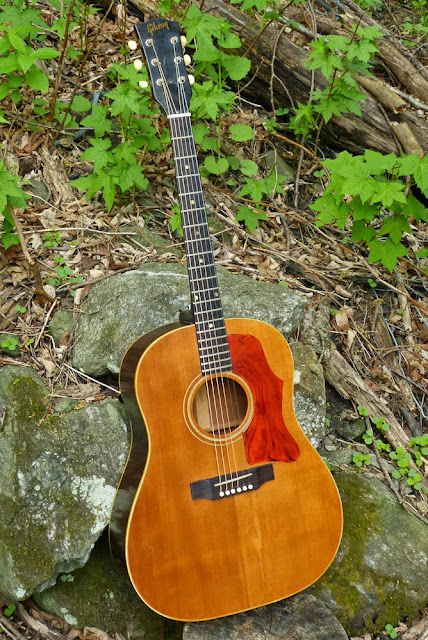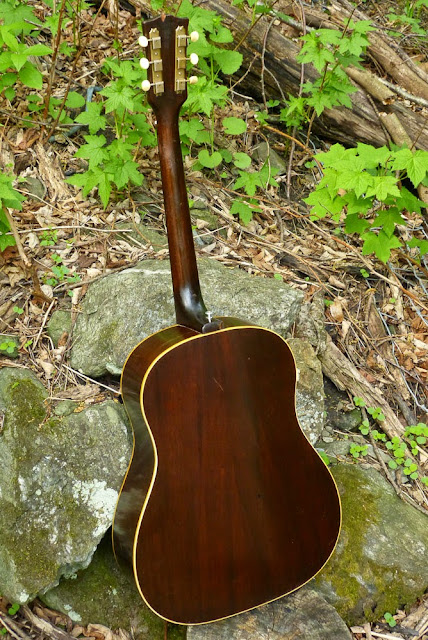1968 Gibson J-50 Slope Dread Guitar
Another J-50, huh? This one is a consignor's and it sure does have that great old slope-shoulder sound that records so perfectly and adapts itself well to any number of genres. My work was a glorified setup -- fret level/dress, new bridge pins, new bone nut, cleaning, saddle recut, and setup. She plays well with "Jake Standard" 3/32" bass and 1/16" treble action at the 12th fret, strung with 12s.
This one started out as a J-50 ADJ with an adjustable bridge and (for this year) the reverse-reverse belly bridge (ie, Martin-shaped). Someone replaced the original bridge with one of the same footprint but with a non-adjustable bone saddle installed. The work was competent and looks good and the whole guitar has that buttery-yellow, aged-in warmth about it.
Like any other J-50, the top is spruce and the back and sides are mahogany -- all solid. The late 60s models like this one have a 1 5/8" nut width and a medium-small C-shaped neck profile. These are the perfect specs if you're doing a lot of barre chords or "rock and roll" chord shapes up the neck. A thumb-over player will find it an "easy squeeze" as well.
I replaced a crummy plastic replacement nut with a new bone one. The truss rod is functional but here's condition issue #1 -- when tuned to pitch the neck gains a hair of relief (1/32" overall) which can't be dialed-out. It's not a big issue to most players as a lot of folks like to have a smidge of relief in the neck so they can bang on chords with authority.
The board has that steeper 60s radius which allows the small nut width to feel a bit bigger than it is, spacing-wise. Fenders from the time with 1 5/8" nuts did the same thing. It's a nice feel but very different from a modern profile which tends to be pretty flat.
I replaced the replacement bridge pins with something more "factory" in looks. The saddle also got compensation and some light string-ramps for better back-angle on the saddle.
The center seam on the top opened up and was professionally repaired (with a nice cleating job) a long time ago. At the same time, a hairline crack (barely through the wood) that's next to it must've also been glued up. Both are stable in service and are the only cracks I've found.
The finish, of course, shows general use and wear and tear and has the usual Gibson weather-checking.
The "black spot" on the back is a ding that was penned-in to darken it up. Otherwise, except for some buckle scratching and general wear, the back is in good shape.
There's a chip in the back of the headstock but it's very small. The original tuners also seem to be doing a decent job.
The off-center strap button addition is curious but works.
Note the small hairline to the right of the heel on the side and the patched crack area to the left of the heel on the side. Good to go.
Someone filled an old jack hole with a dowel... which I've stained and finished quickly to hide it a little better. It's really not obvious... especially since it's in the usual location and hides below the guitar when you're playing.
The original (presumably), grungy old chip case comes with it!





















Comments